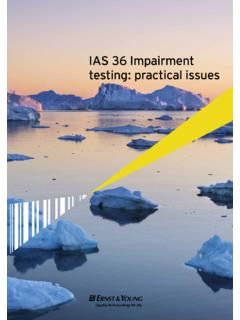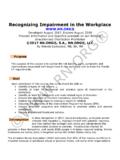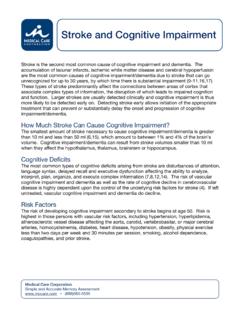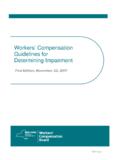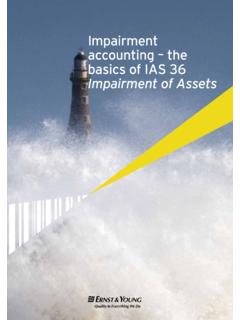Transcription of Policy and Practice - World Health Organization
1 844 Bulletin of the World Health Organization | November 2004, 82 (11)Paper from: Programme for the Prevention of Blindness and Deafness, World Health Organization , 20 Avenue Appia, 1211 Geneva 27, Coordinator. Correspondence should be sent to this author (email: 2 Technical Medical No. 04-012831(Submitted: 2 March 2004 Final revised version received: 15 June 2004 Accepted: 25 June 2004)Global data on visual impairment in the year 2002 Serge Resnikoff,1 Donatella Pascolini,2 Daniel Etya ale,3 Ivo Kocur,3 Ramachandra Pararajasegaram,4 Gopal P. Pokharel,3 & Silvio P. Mariotti3 Policy and PracticeAbstract This paper presents estimates of the prevalence of visual impairment and its causes in 2002, based on the best available evidence derived from recent studies. Estimates were determined from data on low vision and blindness as defined in the International statistical classification of diseases, injuries and causes of death, 10th revision. The number of people with visual impairment worldwide in 2002 was in excess of 161 million, of whom about 37 million were burden of visual impairment is not distributed uniformly throughout the World : the least developed regions carry the largest share.)
2 visual impairment is also unequally distributed across age groups, being largely confined to adults 50 years of age and older. A distribution imbalance is also found with regard to gender throughout the World : females have a significantly higher risk of having visual impairment than males. Notwithstanding the progress in surgical intervention that has been made in many countries over the last few decades, cataract remains the leading cause of visual impairment in all regions of the World , except in the most developed countries. Other major causes of visual impairment are, in order of importance, glaucoma, age-related macular degeneration, diabetic retinopathy and Vision, Low/epidemiology; Blindness/epidemiology; Vision, Low/etiology; Blindness/etiology; Cataract/complications; Glaucoma/complications; Macular degeneration/complications; Refractive errors/complications; Cost of illness; Age factors; Sex factors (source: MeSH, NLM).Mots cl s Baisse vision/ pid miologie; C cit / pid miologie; Baisse vision/ tiologie; C cit / tiologie; Cataracte/complication; Glaucome/complication; D g n rescence maculaire/complication; Troubles r fraction oculaire/complication; Co t maladie; Facteur ge; Facteur sexuel (source: MeSH, INSERM).
3 Palabras clave Visi n subnormal/epidemiolog a; Ceguera/epidemiolog a; Visi n subnormal/etiolog a; Ceguera/etiolog a; Catarata/complicaciones; Glaucoma/complicaciones; Degeneraci n macular/complicaciones; Errores de refracci n/complicaciones; Costo de la enfermedad; Factores de edad; Factores sexuales (fuente: DeCS, BIREME).Bulletin of the World Health Organization 2004;82 page 850 le r sum en fran ais. En la p gina 850 figura un resumen en espa first estimate of the global data on blindness was published in 1995 (1), based on the World population data for 1990. This estimate was extrapolated to the 1996 World population, and to the World population and demographic shifts projected for 2020. These data provided the basis for the 1999 launch of the Global Initiative for the Elimination of Avoidable Blindness, which is known as VISION 2020: the Right to Sight (2).Since the publication of the Global Data on Blindness in 1995, population-based studies on the prevalence of blind-ness and visual impairment have been carried out in nearly all WHO regions.
4 Most of these surveys have used the WHO simplified population-based assessment methodology for visual impairment and causes (3), with some adaptation in a few several countries rapid assessment of cataract surgical services (RACSS) (4) has been conducted (see for example 5 8). The results of these studies also provide general information on the status of visual impairment in adults 50 years of age and older. In addition to the RACSS surveys, many recent studies have specifically targeted older availability of new data has allowed the update of the global and regional estimates of visual impairment and its of the World Health Organization | November 2004, 82 (11) Policy and Practice Serge Resnikoff et al. visual impairment in 2002 MethodsDefinitionsThe definitions for visual impairment , low vision and blindness used in the present study follow those given in the International statistical classification of diseases, injuries and causes of death, 10th revision (ICD-10): H54 (9) where: visual impairment includes low vision as well as blindness; low vision is defined as visual acuity of less than 6/18, but equal to or better than 3/60, or a corresponding visual field loss to less than 20 degrees in the better eye with best possible correction (ICD-10 visual impairment categories 1 and 2); blindness is defined as visual acuity of less than 3/60, or a corresponding visual field loss to less than 10 degrees in the better eye with best possible correction (ICD-10 visual impairment categories 3, 4 and 5).
5 Regions, subregions and population estimatesThe classification of WHO Member States into 17 subregions was carried out according to the Global Burden of Disease 2000 Project (10); for details see Murray et al. 2001 (11).Estimates of population size and structure were based on the 2002 demographic assessment of the United Nations Population Division (12), as used by theWorld Health report 2003 (13).Sources of epidemiological dataRecent survey results from 55 countries were selected (Table 1); in some countries there had been several surveys. The selection criteria were as follows: studies were population-based and rep-resentative of the area sampled. They provided: clear, unequivocal definitions of visual impairment ; both WHO and non-WHO definitions of visual impairment were acceptable if classifiable within the ICD-10 ranges of visual loss; cross-sectional design with a description of sample design and sampling plan; sample size; response rate; assessment of non-sampling errors; and a description of ophthalmic examinations and visual acuity 2002 Global update of available data on visual impair-ment (14) was an important source of data.
6 Results from as yet unpublished surveys that met the relevant criteria were also selected. In the case of countries for which data were scarce, national sources were investigated. These included: ministries of Health , national prevention of blindness programmes, academic institutions, regional WHO offices and consultants. The data on childhood blindness were obtained from the report of a 1999 WHO scientific meeting (15), as well as from a comprehensive review of available data (16).Estimates of prevalencePrevalence of blindness (ICD-10 visual impairment categories 3, 4 and 5)Prevalences for blindness (Table 2) were obtained for the 17 WHO epidemiological subregions using a model based on the data from the 55 countries listed in Table 1 and from other sourc-es, as described below. The model estimated the prevalence of blindness for three age groups: children less than 15 years; adults from 15 to 49 years; and adults aged 50 years and prevalences of blindness in children were estimated for the 17 WHO subregions.
7 This was done using the data from Table 1. Studies used for the global estimate of visual impairment Subregion StudiesAfr-D Surveys from 13 countries (Benin, Cameroon, Cape Verde, Equatorial Guinea, Gambia, Ghana, Mali, Mauritania, Niger, Nigeria, Sierra Leone, Sudan, Togo)Afr-E Surveys from 6 countries (Central African Republic, Congo, Ethiopia, Kenya, South Africa, United Republic of Tanzania)Amr-A Surveys from 1 country (United States of America)Amr-B Surveys from 3 countries (Barbados, Brazil, Paraguay)Amr-D Survey from 1 country (Peru)Emr-B Surveys from 4 countries (Lebanon, Oman, Saudi Arabia, Tunisia)Emr-D Survey from 1 country (Morocco)Eur-A Surveys from 7 countries (Denmark, Finland, Iceland, Ireland, Italy, Netherlands, United Kingdom)Eur-B1 Surveys from 2 countries (Bulgaria, Turkey)Eur-B2 Survey from 1 country (Turkmenistan) Eur-C No population-based surveys were identifiedSear-B Surveys from 4 countries (Indonesia, Malaysia, Philippines, Thailand)
8 Sear-D Surveys from 4 countries (Bangladesh, India, Nepal, Pakistan) Wpr-A Surveys from 1 country (Australia)Wpr-B1 Surveys from 2 countries (China and Mongolia) Wpr-B2 Surveys from 3 countries (Cambodia, Myanmar, Viet Nam)Wpr-B3 Surveys from 2 countries (Tonga and Vanuatu)Afr, WHO African Region; Amr, WHO Region of the Americas; Emr, WHO Eastern Mediterranean Region; Eur, WHO European Region; Sear, WHO South-East Asia Region; Wpr, WHO Western Pacific two reports that had used criteria for grouping of countries similar to those used in the WHO classification of adults aged from 15 to 49 years the prevalences of blindness were estimated for each subregion according to the mortality stratum: for subregions with mortality stratum A ; for subregions with mortality stratum B or C ; and for subregions with mortality stratum D or E (See 13 for the current assignment of mortality stratum to the WHO subregions.)These estimates were based on data from the studies selected and on interpolations previously derived from the data on childhood blindness and data for subjects aged 50 years and older (15).
9 The prevalences for the age group 50 years and older were taken from population-based surveys. Prevalences calculated for the age group as a whole, adjusted for sex and age composition of the sample and/or of the survey area, were used. For areas for which no data were available, prevalence was extrapolated from areas similar in terms of availability of eye and Health care and 846 Bulletin of the World Health Organization | November 2004, 82 (11) Policy and PracticeVisual impairment in 2002 Serge Resnikoff et al. epidemiology of eye diseases and services for which data were available. Population size in different areas was estimated from national census data; population structure was determined from the United Nations estimate for that other instances, the data from one area were estimated to be representative of the country as a whole and applied to all the population. Finally, some surveys provided nationwide countries for which recent epidemiological data were not available, the prevalence of blindness was extrapolated from data collected in countries within the same subregion or from neighbouring subregions that share similar epidemiological, socioeconomic, ecological and eye care service prevalence was used to estimate the total number of blind people in each country of a subregion.
10 This number was then used to calculate the subregional preva-lence of blindness. This method could not be applied to the subregion Eur-C, as no suitable population-based surveys were available for any of the countries of this subregion: in this case the prevalences were assumed to be the same as for the subregion of low vision (ICD-10 visual impairment categories 1 and 2)The prevalences of low vision for each subregion was estimated from the same surveys as were used to determine the prevalence of blindness. Owing to the paucity of data on age-specific preva-lence of low vision it was not possible to construct a model similar to that described above for blindness. Specific preva-lences for both blindness and low vision were reported in 43 studies from 15 subregions; additional studies that reported data on low vision in children were also taken into account (17 20). The extrapolations between countries made for blindness were Table 2. Age-specific prevalence of blindness and number of blind people, by age and WHO subregion, 2002a Prevalence of blindness (%) No.










